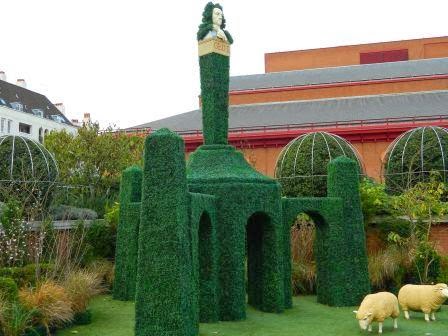Last Saturday I had the great pleasure
of visiting the British Library, London, and their ‘Georgians Revealed’
exhibition.
To enter the library the visitor first
crosses a piazza containing a pop-up garden with a column topped by King George
I wearing a privet wig! I knew then I was going to enjoy myself. Indeed, the
contrasting backdrop of modern London against the 18th century, and
the cheekiness of clothing King George in greenery, set the tone for an
exhibition carrying the message that the Georgians were an innovative lot,
driven by consumerism.
 |
| Author's own photo |
The exhibition celebrates the 300th
anniversary of George I acceding to the English throne (in 1714) – a new king
whose heirs oversaw a momentous century of change. The impression left by the ‘GeorgiansRevealed’ was of a time where architecture, fashion, literature and theatre
gathered momentum, took root and indeed had a feel of the modern age about it
(minus the internet of course!)
 |
| Author's own photo |
Perhaps it was because the venue was a
library, but the importance of books and pamphlets in the 18th
century struck me as incendiary. From the handbills promoting pantomimes, to
step-by-step dance instructions; from magazines and fashion plates, to learned
volumes on architecture – printed matter was key to spreading information
beyond the privileged few to a wider audience.
The 18th century was revealed
as a time of ‘firsts’. Institutions that are still important today, such as the
British Museum and the Royal Academy of Art, were founded. Most people know of
Mrs Beeton and her famous Victorian cookbook, but have you heard of her
fore-runner, Hannah Glasse who in 1747 produced the Georgian equivalent?
Indeed, in 1754 Thomas Chippendale produced the first illustrated catalogue of
furniture, and in 1765 Josiah Wedgewood opened his first London showroom
selling fine china and porcelain.
 |
| Author's own photo |
Hobbies and pastimes that are familiar
to us today had their root in the 18th century. For instance an
early form of tourism, visiting the country house, was popular and some venues
such as Lord Cobham’s estate in Stowe produced their own guidebooks.
Ladies magazines such as the ‘Ladies
Complete Pocket Book’ printed fashion plates with exhaustive descriptions of
the latest gowns. This meant anyone could copy the designs and up-to-date
fashion spread beyond the aristocracy. Fashion celebrities such as Fanny Murray
were spawned, whilst printed cartoons by Rowlandson, Gilray and Cruikshank made
it legitimate to laugh at ones superiors publicly in a way previously frowned on.
 |
| Author's own photo |
It was also a time of huge growth for
the city of London itself. Until the mid-18th century there were
just five bridges across the Thames, but to feed the growing capital more were
built. London expanded across fields and farms, many of today’s landmark
squares were designed and created by architectural greats such as Adams,
Palladio and Soane. Again, the magic of the exhibition was not just seeing
contemporary prints of the buildings these architects created, but viewing the
actual books they wrote and published.
If you haven’t guessed by now, I felt
thoroughly inspired by the ‘Georgians Revealed’ and the exhibition is open
until 11th March 2014 at the British Library (they also have a
pretty awesome gift shop, which is basically a book store. Heaven.)
.jpg) |
| With thanks to Cheezburger.com |


Bradshaw took me past The British Library this week and on your recommendation I plan to visit the exhibition. You asked about Christmas lights - http://londondiaryblog.wordpress.com/2013/12/11/the-christmas-lights/
ReplyDeleteI hope you enjoyed your visit, Candy.
DeleteWe don't have these in Utah, but they certainly look fun. I enjoyed your advent post very much. Have a Merry Christmas. kelley—the road goes ever ever on
ReplyDelete